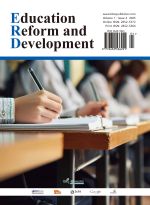The Significance and Path of the Organic Integration of High School English Teaching and Chinese Excellent Traditional Culture
Abstract
Under the background of the current education reform, combining high school English teaching with excellent traditional Chinese culture can not only enrich the content of English teaching, but also enhance students’ sense of identity and pride in their own culture. Therefore, teachers should be aware of the importance of traditional culture, the use of multi-form teaching methods in English teaching to penetrate traditional culture. In this way, it can not only stimulate students’ interest in learning, but also help them to deeply understand and inherit traditional culture while learning English, feel the profound heritage and unique charm of traditional culture, and enhance students’ intercultural communication ability, so as to comprehensively improve the effectiveness of senior high school English teaching. In this regard, this paper first expounds the significance of integrating excellent traditional Chinese culture in senior high school English teaching, and then puts forward effective ways to integrate it, in order to provide some references for relevant education researchers.
References
Ma W, 2025, A Way to Infiltrate Excellent Traditional Chinese Culture in High School English Teaching under “New Curriculum Standards”. Weekly, 2025(3): 140–142.
Liu M, 2024, Problems and Countermeasures of Integrating Excellent Traditional Chinese Culture into High School English Teaching. Journal of Changchun University of Education, 40(6): 105–109.
Xie L, 2024, The Excellent Traditional Chinese Culture Embodied in High School English Textbooks and Its Teaching Enlightenment. Teachers of English, 24(24): 184–186.
Tu S, 2024, Strategies for Integrating Excellent Traditional Chinese Culture into High School English Teaching. Jiangxi Education, 2024(47): 13–14.
Xu H, 2024, Discussion on the Integration of Excellent Traditional Chinese Culture into High School English Teaching. Journal of Dalian Institute of Education, 40(4): 33–35.
Guo Y, 2024, A Study on the Presentation of Excellent Traditional Chinese Culture in High School English Discourse Based on New Curriculum Standards. Selected Chinese Loose-leaf Texts (Teaching and Research of Traditional Culture), 2024(12): 67–69.
Gu Z, 2024, The Integration of Excellent Traditional Chinese Culture into Senior High School English Teaching. English for Middle School Students, 2024(46): 35–36.
Hua F, 2024, Deep Integration of Chinese Excellent Traditional Culture and High School English Teaching. College English, 2024(47): 57–59.
Liu F, 2024, A Strategic Study on the Integration of Excellent Traditional Chinese Culture into High School English Teaching. Teachers, 2024(32): 54–56.
Zheng X, 2024, Exploring the Integration Path of Chinese Excellent Traditional Culture with High School English Teaching. Examination Weekly, 2024(45): 101–104.
Wang C, 2024, Research on the Strategies of Integrating Excellent Traditional Chinese Culture into High School English Teaching under the Background of Core Literacy. Anhui Education and Research, 2024(30): 46–48.
Jiang F, 2024, The Significance and Strategy of Organic Integration of High School English Teaching and Excellent Traditional Chinese Culture. College Entrance Examination, 2024(30): 50–52.
Li Y, 2024, Action Research on the Integration of Excellent Traditional Chinese Culture into High School English Reading Teaching. English on Campus, 2024(41): 27–29.
Jiang X, 2024, The Strategy of Integrating Chinese Excellent Traditional Culture into High School English Teaching. College Weekly, 2024(36): 140–142.
Chen G, 2024, A Brief Analysis on the Penetration of Excellent Traditional Chinese Culture in Senior High School English Teaching. Knowledge Library, 40(22): 39–42.

